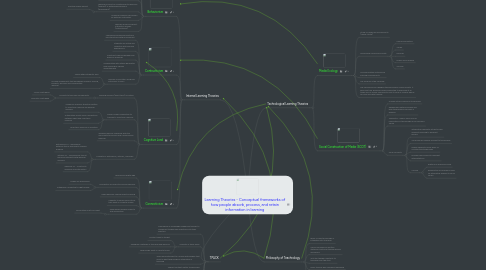
1. Internal Learning Theories
1.1. Behaviorism
1.1.1. Brain is a blank slate and is filled with information by external stimuli
1.1.2. Learning predicated by change
1.1.3. Learning measured by observable behavior
1.1.4. Learning is result of conditioning to reinforce (operant) or extinguish behaviour (punishment)
1.1.4.1. Practice makes perfect
1.1.5. Learning is passive and driven by extrinsic motivators
1.1.6. Teacher driven and direct instruction are key (Instructivism)
1.2. Contructivism
1.2.1. Learning is building connections by interactions with environment
1.2.2. Students are active and reflective with learning experiences
1.2.3. Construct own knowledge from previous learnings
1.2.4. Collaboration with others generates new meaning by shared understanding
1.2.5. Teacher is facilitator and gives autonomy to learn
1.2.5.1. Teach within student's ZPD
1.2.5.2. Provide assignments that emphasize problem-solving, projects, discover and collaborative learning
1.3. Cognitive Load
1.3.1. Working memory (short-term) is limited
1.3.1.1. Consists to two main components
1.3.1.1.1. Visual scratchpad
1.3.1.1.2. Phonetic scratchpad
1.3.2. Person makes connection to transfer to long-term memory
1.3.2.1. Schema is memory structure written to long-term memory by working memory
1.3.2.2. Automation results from connections between short and long-term memory
1.3.2.3. Long-term memory is unlimited
1.3.3. Working memory overloads with too much data to process and compromises learning
1.3.4. Consists of Extraneous, Intrinsic, Germane
1.3.4.1. Extraneous CL - imposed by external stimuli and diverts schema building
1.3.4.2. Intrinsic CL - impoased by task at hand and interacts with working memory
1.3.4.3. Germane CL - constructs schemas and automation
1.4. Connectivism
1.4.1. Learning for digital age
1.4.2. Connection of nodes to info and services
1.4.2.1. Nodes are specialized
1.4.2.2. Databases connected to right people
1.4.3. Rapid decision making effects learning
1.4.4. Capacity to know more critical than what is currently known
1.4.5. Know where access nodes to find information
1.4.5.1. Information must be curent
2. Technological Learning Theories
2.1. Media Ecology
2.1.1. Study of media as environments (Lance Strate)
2.1.2. Technology influences society
2.1.2.1. Human perception
2.1.2.2. Values
2.1.2.3. Feelings
2.1.2.4. Power and influence
2.1.2.5. Survival
2.1.3. Communication systems are learning environments
2.1.4. The medium is the message
2.1.5. The cell phone has changed the way people communicate. It give near true feeling of being connected to everyone at all times and no longer confined to face to face or landline phone for calls and data transfer
2.2. Social Construction of Media (SCOT)
2.2.1. Human action influences technology
2.2.2. Researchers determine who and how technological success is defined
2.2.3. Symmetry - deploy same find of information in technological success and failure
2.2.4. Core conceots
2.2.4.1. Interpretive flexibility-artifacts have different meaning to different groups
2.2.4.2. Social groups-groups relevant to technology
2.2.4.3. Design flexibility-many ways of constructing technology
2.2.4.4. Problems and conflicts-different interpretations
2.2.4.5. Closure
2.2.4.5.1. Rhetorical-problem solved
2.2.4.5.2. Redefinition of problems-need for alternative designs to solve issues
3. TPACK
3.1. Framework of knowledge needed by teacher to implement technology effectively into their practice
3.2. Consists of three areas
3.2.1. Content-what is taught
3.2.2. Pedagogy-methods of teaching and learning
3.2.3. Technology-what is used to teach
